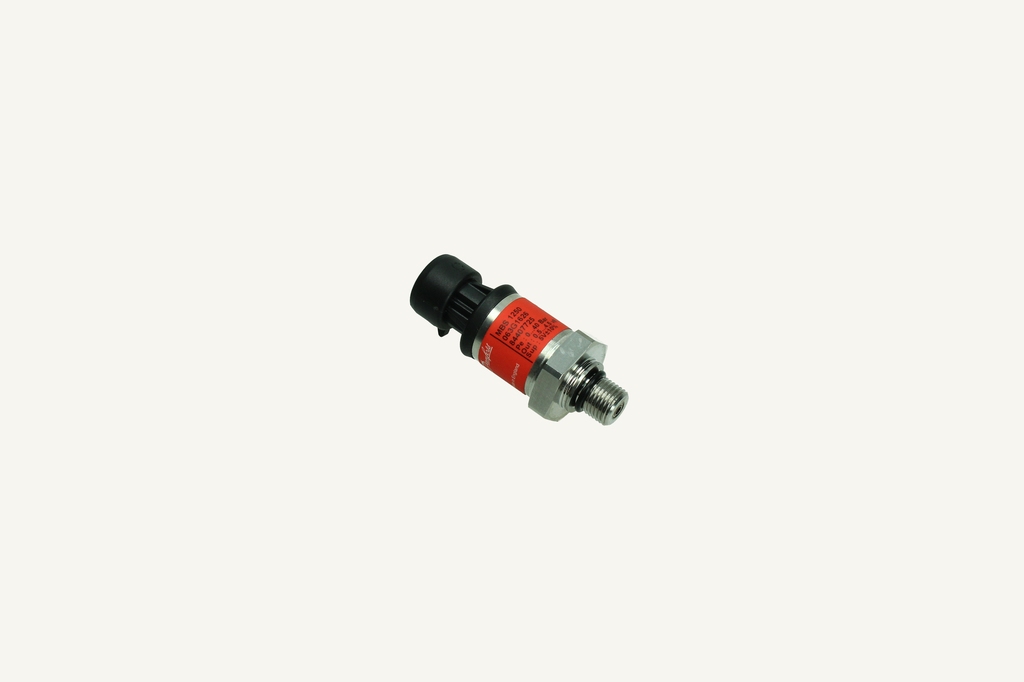CHF 267.80
CHF 267.80
excl. VAT
Available: 1.0 Units
This combination does not exist.
Units of Measure: Units
Add to basket
Product information:
0-40bar; 5 Volt
Note: This information only applies to tractors equipped with the CVT transmission.
Fault code 2615 indicates that the transmission torque pressure sensor has an open circuit or is shorted to ground.
When the ignition switch is in the ON position, a torque sensor voltage of less than 0.44 volts will trigger fault code 2615.
Check for source voltage and clean the ground at the torque pressure sensor terminal (C75).
With the ignition switch in the ON position, measure the voltage between terminal C75 pin 1 and C75 pin 2 on the harness side of the terminal (C75).
If it does not read 5 volts, the problem is not with the torque pressure sensor - see Workshop Manual, Section 55 Chapter 5 under fault code 2615 for further troubleshooting.
If 5 volts is displayed, go to step 2.
Install the electronic maintenance tool and monitor the torque pressure sensor voltage.
Turn the ignition switch to the run position.
If the voltage is below 0.44 volts, fault code 2615 is displayed.
Start the tractor. Does the voltage reading change or exceed 0.44 volts?
Move the direction change lever to the forward or reverse position. Press the speed control pedal and apply the brakes to load the driveline. The voltage reading of the torque sensor should increase.
If this is the case, there is no short circuit to ground and no open circuit in the torque pressure circuit. Replace the torque sensor (part number 87678027).
If there is no voltage change, go to step 3.
Check for an open or short to ground on the torque pressure signal circuit.
Disconnect terminal C61, located on the transmission control unit (TCU), and terminal C75.
Check for continuity between terminal C75 pin 3 and terminal C61 pin J1-17.
If the wiring harness is OK, replace the torque pressure sensor.
If the wiring harness is not OK, see workshop manual, section 55, chapter 5 under fault code 2615 for further troubleshooting.
**A new torque pressure sensor is available from the parts department that seals better around the sensor connector port. The part number (87678027) has not been changed, but the connector has two additional outer ribs for easy visual identification - shown as reference A in the attached document (87678027). All sensors ordered from the spare parts department are of the new design.
This information only applies to Easy Drive/CVTS transmissions!
There are two possible reasons why the unit stops when the cruise control pedal is engaged:
Regardless of whether the anti-lock switch (on the left sleeve) is in the engaged position or not, the logic from the transmission control module discharges the forward or reverse clutch pressure when the engine speed drops below 800 rpm. When using the unit at low speed and in low idle situations, it is advisable to set the manual throttle to a higher engine speed and not rely solely on the speed control pedal for engine speed control.
Under high load conditions, there is torque limiting logic to protect the transmission from excessive torque. The torque value through pulley 2 is measured by the torque pressure sensor (part number 87678027) located on the right side of the driveline, just in front of and above the four-wheel drive solenoid. The torque limiting control logic becomes active at approximately 20 bar (2.5 volt reading on the EST tool). The control logic limits the driveline torque by lowering the pressure to the forward or reverse clutch to allow the clutch to slip to keep the torque on the variator below the torque limit. If the driver presses the accelerator pedal after the torque limit has been reached, the clutch is fully released and a "Release pedal (Rp)" appears on the analogue/digital instrument cluster (ADIC). When the load decreases, the pressure to the clutch may decrease to allow the drive to continue. If the load does not decrease, the operator must switch to the opposite drive direction to reduce the torque load and allow movement. In some cases, the change in drive direction may not allow a decrease in torque and the operator must move the forward/reverse direction change lever to neutral and apply the parking brake. The operator must then wait seven seconds to activate the standstill valve to release the pressure from the P1 pulley. The operator can then move the tractor.
Checkout





